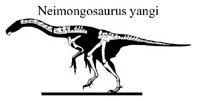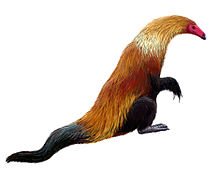Neimongosaurus
| Neimongosaurus Temporal range: Late Cretaceous, c 85 Ma.
| |
|---|---|

| |
| Skeletal restoration | |
| Scientific classification | |
| Domain: | Eukaryota |
| Kingdom: | Animalia |
| Phylum: | Chordata |
| Clade: | Dinosauria |
| Clade: | Saurischia |
| Clade: | Theropoda |
| Family: | †Therizinosauridae |
| Genus: | †Neimongosaurus Zhang et al., 2001 |
| Species: | †N. yangi
|
| Binomial name | |
| †Neimongosaurus yangi Zhang et al., 2001
| |
Neimongosaurus ("Nei Mongol lizard") is a genus of herbivorous therizinosaur theropod dinosaur known from the Upper Cretaceous of Nei Mongol, China.

Neimongosaurus is a therizinosauroid which is known from the holotype LH V0001, a partially preserved skull and skeleton, consisting of a partial braincase, the front of the right lower jaw, a nearly complete axial column, a furcula, the shoulder girdle, both humeri, a left radius, parts of the pelvis and parts of the hindlimbs. The specimen was in 1999 collected in the Sanhangobi in Inner Mongolia from the Iren Dabasu Formation dating from the Santonian stage about 85 million years ago. A second specimen, LH V0008, consisting of a sacrum with ilia, was assigned as the paratype.[1]
The type species, Neimongosaurus yangi, was formally named and described by Zhang Xiaohong, Xu Xing, Paul Sereno, Kwang Xuewen and Tan Lin in 2001. The generic name is derived from Nei Mongol, the Chinese name for Inner Mongolia. The specific name honours Yang Zhongjian.[1]
Neimongosaurus was bipedal. The teeth in its deep lower jaw, coarsely serrated, indicate an herbivorous diet. It had elongated cervical vertebrae. Its scapula had a tapering end.[1] Neimongosaurus is thought to have been about 2.3 meters in length.
Neimongosaurus was by the describers assigned to the Therizinosauroidea, in a basal position.[1] Subsequent cladistic analyses have indicated a position in the more derived Therizinosauridae,[2] but an analysis in 2010 by Lindsay Zanno confirmed the original placement.[3]
See also
References
- ^ a b c d Zhang, Xu, Sereno, Kwang and Tan, (2001). "A long-necked therizinosauroid dinosaur from the Upper Cretaceous Iren Dabasu Formation of Nei Mongol, People’s Republic of China." Vertebrata PalAsiatica, 39(4): 282-290.
- ^ Senter, P. (2007). "A new look at the phylogeny of Coelurosauria (Dinosauria: Theropoda)." Journal of Systematic Palaeontology, 5: 429-463 (doi:10.1017/S1477201907002143).
- ^ Lindsay E. Zanno (2010). "A taxonomic and phylogenetic re-evaluation of Therizinosauria (Dinosauria: Maniraptora)". Journal of Systematic Palaeontology. 8 (4): 503–543. doi:10.1080/14772019.2010.488045.










